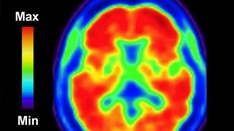Brain levels of TAR DNA binding protein 43 (TDP-43), a key factor in the neurodegeneration that occurs with Alzheimer's disease, begin declining nearly two decades prior to the end of life and show an independent effect on the rate of hippocampal atrophy that occurs with the disease, new research shows.
"TDP-43 Is strongly associated with changes early in the atrophic process with strong relationships throughout the last 17 years of life," first author Marina Buciuc, MD, of the Department of Neurology, Mayo Clinic, Rochester, Minnesota, said in presenting the findings as part of the American Neurological Association's ANA 2020 Virtual Annual Meeting.
"It also appears that the proteins TDP-43 and tau have different contributions to acceleration and deceleration in the rate of hippocampal atrophy over time in Alzheimer's disease," she said.
Commenting on the study, Eric McDade, DO, who moderated the session, said the study offers important insights in the quest to understand the complexities behind late-life dementia.
"These findings further support the importance of considering the multitude of pathologies that can contribute to cognitive decline, even in the presence of significant Alzheimer disease pathology, particularly in those in the ninth decade," said McDade, an associate professor of neurology at the Washington University School of Medicine, in St. Louis, Missouri.
Although the presence of plaques of beta-amyloid and neurofibrillary tangles (NFTs) of tau are key hallmarks of Alzheimer's disease, TDP-43 has gained recognition in recent years as playing an important and intriguing role, showing an independent association with hippocampal atrophy, memory loss, and the presence of the apolipoprotein epsilon 4 risk allele (APOE4).
In the new study, Buciuc and colleagues sought to better understand how those TDP-43 markers correspond with disease progression over time.
"It is unknown at present whether TDP-43 is linked to acceleration of the hippocampal atrophy rate in Alzheimer's disease and whether such acceleration of the rate occurs far from death or close to death," she said.
For the study, the team evaluated 1638 antemortem volumetric head MRI scans from 557 autopsy-confirmed cases of Alzheimer's disease collected 1 to 17 years prior to death between 1992 and 2015 in the Mayo Clinic Alzheimer's Disease Patient Registry in the Mayo Clinic Study of Aging.
Of the patients, 51% (284) were women; 45% (245) were TDP-43–positive, and 47% (261) were APOE4 carriers. The median age of the patients at death was 86 years.
The evaluation of neuropathologic changes, which spanned 17 years of disease, showed that a higher TDP-43 stage was significantly associated with the acceleration of hippocampal atrophy as long as 15 years prior to death, with a deceleration of the atrophy occurring in the 5 years before death.
Lower TDP-43 stage was associated with slower early rates of hippocampal atrophy, and rates accelerated closer to death. The later acceleration was highly associated with tau Braak NFT stage.
The associations with changes in atrophy were observed with TDP-43 and Braak NFT regardless of whether the changes in neuropathology were mild or moderate-severe.
Although the team's previous research had also demonstrated independent effects of TDP-43, "we were surprised that even 15 years before death, the brain has already undergone a significant amount of atrophy, some of which we think is due to TDP-43," Buciuc told Medscape Medical News.
"The present study adds to current knowledge by providing evidence that the rate of atrophy (acceleration and deceleration) is not constant and is faster earlier in the disease (at least a decade prior to death) but slows down closer to death, likely due to a very atrophic hippocampus at that point in time," she said.
"The significance of this finding is that TDP-43 seems to be affecting the brain shrinkage of this key region very early in time, ie, before 15 years from death," she noted.
The differences in the timing of brain changes could have therapeutic implications, Buciuc added.
"Hence, treatment targeting TDP-43 is important to treat Alzheimer's disease, and it will need to be administered very early in time to be most effective. For this we will need to be able to identify TDP-43 early."
Of note, Buciuc said that although only 45% of patients in the current study were TDP-43–positive, the rate is likely higher among patients with Alzheimer's disease.
"In the study, we also included patients who did not have Alzheimer's disease and had PART [primary age-related tauopathy – tau deposition without amyloid], many of whom were normal at the time of death," she explained. "Hence, the frequency does not reflect the frequency in Alzheimer's disease."
Considering only cases of Alzheimer's disease, the frequency is much higher ― in some cases, greater than 70%, she noted.
"Furthermore, the frequency is based on screening just one hemisphere, so it very likely that we are still underestimating the frequency of TDP-43 in Alzheimer's disease," Buciuc said.
McDade commented that a key question for future clinical trials should be if and how the treatment of tau affects TDP-43.
"It there are therapies that could effectively lower neurofibrillary tau, it will be important to consider if TDP-43 pathology continues to contribute to cognitive decline," he said.
He added that there is a question as to whether the findings are generalizable to the larger population.
"As is the case with many studies from the Mayo Clinic, the population, although exceptionally well characterized clinically and neuropathologically, is a relatively homogeneous population, and in this study, quite old," he said.
"Thus, it will be helpful to compare these to populations of greater genetic, racial, and cultural backgrounds," he said.
Buciuc and McDade have disclosed no relevant financial relationships.
ANA 2020: 145th Annual Meeting of the American Neurological Association: Abstract 552. Presented October 9, 2020.
For more Medscape Neurology news, join us on Facebook and Twitter.
Medscape Medical News © 2020
Send news tips to news@medscape.net.
Cite this: TDP-43 Protein Declines Years Before Death in Alzheimer's - Medscape - Nov 09, 2020.











Comments